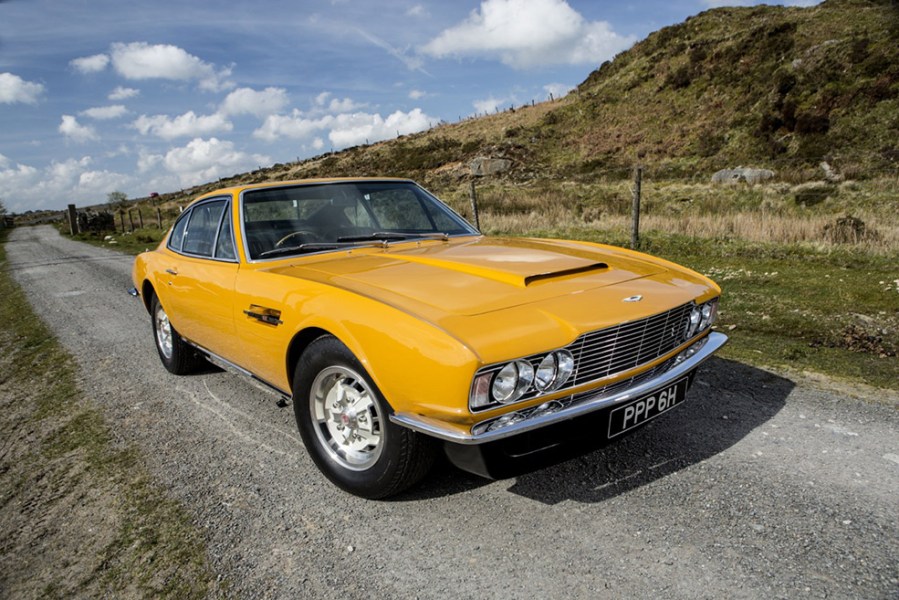1. EMERGENCY TRANSPLANT
The DBS was intended to be released with an all-new, Tadek Marek- designed V8 engine, but this simply wasn’t ready in time for the car’s launch. Aston used the four-litre straight-six from its DB6 as a placeholder, imbuing the car with a distinctly traditional character despite its up- to-date ’Seventies styling. The six-cylinder car was belatedly joined by the DBS V8 in 1969; the two were built alongside each other until 1972 when they were replaced by the Vantage and
V8 respectively.
2. PREMIUM BOND
Aston Martin and James Bond have been synonymous with each other since a DB5 starred alongside Sean Connery in 1964’s Goldfinger. Over the years, Bond has found himself behind Astons of all kinds, including the V8, Vanquish and, most recently, the purpose-built DB10 in 2015’s Spectre. It’s often forgotten, however, that Bond got behind the wheel of a DBS while On Her Majesty’s Secret Service in 1969. This was a pairing that would come to be reprised in the 2006 reboot of the franchise, Casino Royale, albeit with the DBS’s modern, V12-engined namesake in the starring role. A yellow DBS famously starred in the early ’Seventies television series The Persuaders! alongside Bond actor Roger Moore.
3. RACING PEDIGREE
While the DBS never raced as an official Aston Martin works machine, it did take to the track in earnest thanks to an enthusiastic privateer named Robin Hamilton. As the owner of Robin Hamilton Motors, an independent Aston specialist, Hamilton was well placed to create a DBS for the track; his car was extensively modified and eventually homologated for international racing, gaining the name RHAM/1. The car (and Hamilton) raced at Le Mans three times (in 1977, 1978 and 1980); David Preece, Mike Salmon and Derek Bell were amongst the other drivers to join Hamilton for driving duties during RHAM/1’s late ’Seventies/early ’Eighties heyday.
4. PERKS OF THE JOB
Sir David Brown, owner of Aston Martin from 1947 until 1972, used a one-off four-door DBS V8 as his personal car. The lengthened car was built in 1969 and was a prototype for the subsequent limited run of single-headlight production versions that arrived in the mid ’Seventies. The car would ultimately pave the way for the wedge-shaped Lagonda, which in turn inspired modern four-door Astons like the Rapide and Lagonda Taraf.
5. DASHING DESIGN
The man responsible for the handsome lines of the DBS was William Towns, a designer whose primary role at Aston Martin was the development of seats and other interior parts. Towns had mocked up a design for what would become the DBS in his own time; little did he know that Aston Martin boss David Brown would be suitably impressed to give the design the go-ahead for production. The DBS’s macho, purposeful shape set the tone for an entire generation of Aston Martins that didn’t end until the last Vantage
Volante was built in 2000.
6. BIG NUMBERS
The DBS was a fast car for its day in any given configuration. The original straight-six car boasted 282bhp, a sub-eight-second 0-60mph time and a top speed of just over 140mph; the updated V8 version duly added nearly 100bhp, cut a second off the acceleration benchmark time and powered the DBS V8 to 160mph, making it one of the fastest cars in the world in period.
7. PRETTY PERFORMANCE PROTOTYPE
During the development of the DBS V8’s all-new 5.3-litre V8 engine, engineers got creative, squeezing the unit into the engine bay of the iconic DB5 to test its capabilities on the road. Resplendent in dark blue paint and minus its usual chrome bumpers, the car was fully restored in the early ‘Noughties by marque specialist RS Williams.
8. MIDAS TOUCH
The Bahama Yellow DBS that starred in Roger Moore television vehicle The Persuaders! set the classic car auction world alight in 2014 when it was sold by Bonhams for a staggering £533,500, setting a world record for the model. The car had enjoyed a full restoration at the hands of Aston Martin Works in the ’Nineties, returning it to its original filming specification. Interestingly, the car was powered by a six-cylinder despite its DBS V8 appearance and badging; Aston wanted to promote its latest model but couldn’t supply a V8 in time!
9. BLOOD BROTHERS
The DBS was supposed to be a direct replacement for Aston Martin’s aging DB6, but the two cars were actually built alongside each other from 1967 until 1970. The two cars shared more than you might imagine – they utilise a similar chassis (widened in the DBS), the same engine and both cars used a similar front suspension set-up.







